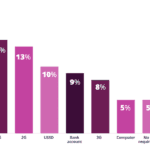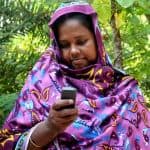Egypt on the Precipice: Can Fintech Pave the Way for a More Inclusive Financial System?
Although Egypt has been on the verge of a breakthrough in financial access for decades, its growth in financial inclusion has persistently lagged behind similar economies. The initiatives have been many: directives from the government on lending for micro, small and medium enterprises (MSMEs); lines of credit from international financial institutions; hundreds of millions of dollars in donor funds into institutions tasked with supporting microfinance and bank lending to MSMEs; and most recently, technical assistance and funding to support digitally enabled financial services.
The result? A 3 percent increase in adult account ownership — from 11 percent to 14 percent — from 2011 to 2014, according to the most recent Findex, a World Bank report released every three years on the state of global financial access. The next Findex will be released in April, and Egypt-watchers are hoping that the long-awaited (and heavily funded) big jump in access will be a documented reality. But to date, the return on investment has underperformed, especially when it comes to transforming the lives of low-income people.
That said, the reasons for optimism are many. Egypt has all the hallmarks of a market ready to leapfrog: a population of 93 million, 21.7 million of whom are between the ages of 18 and 29; more mobile subscriptions (110 million) than its population; and enthusiastic embrace of social media — Facebook alone has more than 37 million users each month.
Perhaps the most promising development is the emergence of serious new financial services providers (FSPs) in Egypt. Fawry, launched in 2008, is an e-payment aggregator that currently reaches 20 million Egyptians and processes 1.6 million transactions per day, at 75,000 service points. Fawry enables payments online, using ATMs, through mobile wallets, or at retail agents. Masary, launched in 2009, is a payment processor and aggregator with 45,000 service points and more than 500,000 subscribers.
PayMob, launched by recent graduates of American University in Cairo, offers businesses payment acceptance online, via mobile wallet, and in-store. It connects merchants to modern-day payment solutions so that they can improve enterprise-wide efficiency and expand into e-commerce, potentially increasing their market significantly.
Another newcomer is MoneyFellows, a digital ROSCA (rotating savings and credit association). In a country where savings clubs — or “Gam-eya”— are standard practice and a large segment of the population is active on social media, a digital ROSCA is a behaviorally informed way to nudge a population that relies on informal financial services toward more formal ones. MoneyFellows allows clients to form a digital ROSCA with their own circle of friends, just as they would in the real world, or to join a public circle. Clients without a track record start at lower circle amounts but can eventually work up to much larger circles. MoneyFellows intends to use the data of circle members’ monthly contributions to develop digitally enabled individual credit products.
All these new Egyptian fintechs are in addition to the many e-wallet services that have also launched, including Phone Cash (Fawry and National Bank of Egypt), Orange Money (with BNP Paribas), Vodafone Cash (with Housing and Development Bank), and Flous (Etisalat and National Bank of Egypt). PayFort, an Amazon-owned company, has been active since 2014 supporting merchant acceptance to improve e-commerce across Egypt, partnering with Fawry, the Egypt Post, and all the major banks in Egypt to facilitate payment collection at any of those partners’ agents or branches.
The pace and scale of innovation in the payments space is exciting. The question is whether these solutions are expanding access to previously unserved segments or whether they are improving convenience for a market already served. To date, there are an estimated 6 million mobile money accounts in Egypt, however many are dormant. So there is still a lot of room for growth even within the 22 million-person segment of “digitally active” 18- to 27-year-olds. The bigger issue is: How to move beyond payments processing to meaningful financial inclusion— to a holistic approach that includes affordable credit, savings opportunities and budgeting tools?
We believe that there are at least four criteria that a solution must meet in order to reach low-income people:
- Value for the customer: Although the many payment solutions on the market are steadily expanding their offerings, it is not yet clear if they are meeting the needs of low-income people. FSPs first need to have a deep understanding of the needs of the low-income market and then provide solutions that directly address those needs. Many of the existing solutions seem geared to support e-commerce or B2B services. But what do low-income consumers need and want to use? Will the solutions enable informal or unregistered businesses to participate in the digital economy, thus offering a path for low-income customers out of the cash-only economy? Or will the solutions require additional paperwork and hoops to jump through, effectively barring those in the informal sector? Do users need a bank account or credit card to be able to use the solutions? If so, then most of Egypt’s low-income are de facto excluded. Payments solutions also tempt FSPs and other stakeholders to let the good be the enemy of the excellent. That is, they provide a relatively easy way to “check the box” on a financial inclusion agenda without moving on to develop other vital financial opportunities like cash flow management, savings opportunities and insurance.
- Accessibility and affordability: Service points are expanding rapidly in Egypt, and many are going well beyond Cairo. Accessibility for low-income people also means low-cost and usable without sophisticated technological know-how. However, the ubiquity of mobile money points in markets in sub-Saharan Africa like Kenya is not yet found in Egypt, although the market is growing, and is estimated around 100,000 agents.
- Ease of Registration: Although several regulatory enablers are needed for digital financial services to take off, the rules that govern the documentation needed to open a basic mobile money account should reflect what low-income people can actually produce without undue burden. In Egypt, mobile money providers require customers to have national IDs or passports to open an account, which limits access, particularly for women.
- Recognize the unique needs of women clients: In Egypt, women are more likely to have lower-end phones, less access to identification documents and lower levels of literacy. In addition, they may be reluctant to share information or seek assistance regarding a financial transaction from a male agent. Providers who are serious about expanding access to low-income people and not exacerbating the gender gap will need to consider contextually appropriate marketing, having more female agents, and other tactics to encourage and enable account usage by women.
All four of these things are important; none is impossible, as experiences in other countries around the world have borne out. We believe that Egypt is poised to be the “next big thing” for digital financial services, much like a movie star who becomes an “overnight sensation” after years of good work in small roles. The time is ripe — ingenuity, innovation and opportunity are in abundance among the large number of startups — and they are ready for their close-ups.
Sarah Willis is a program manager at MetLife Foundation (a NextBillion partner), where she oversees a global portfolio of financial inclusion initiatives focused on digital and innovation.
Mayada El-Zoghbi leads CGAP’s Strategy, Research and Development unit supporting CGAP’s role as the leading global knowledge hub on financial inclusion.
Photo of El-Moez Street, Old Cairo, Egypt, courtesy of Wikimedia Commons
Note: An Arabic version of this post can be found on CGAP’s Microfinance Gateway.
- Categories
- Finance




